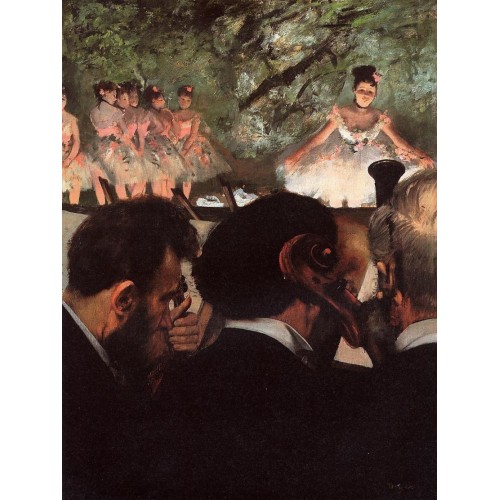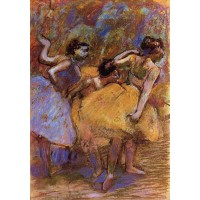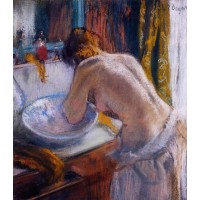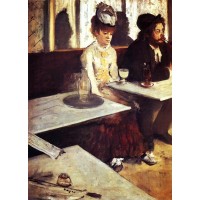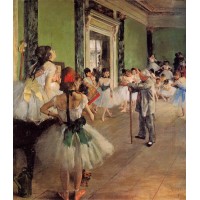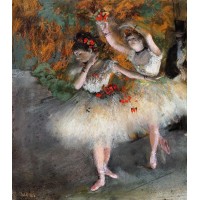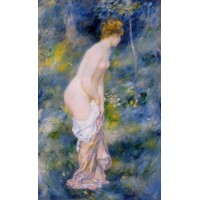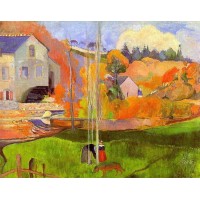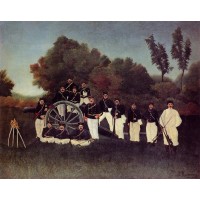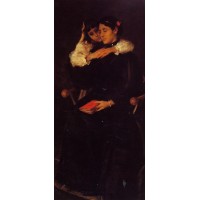Musicians in the Orchestra
Artist: Degas
In 1853 Degas began to frequent the Louvre, where he made copies of the works of the great masters. Two years later he entered the studio of Louis Lamothe, a pupil of Ingres, and ac-quired there a sound technical training, inheriting from his teacher a passion for drawing that was to remain a constant feature of his art.
Between 1856 and 1859 the artist paid several visits to Italy, and in particular to Florence, where he stayed with some relatives of his, the Bellelli family. In fact one of the most interesting paintings of those years is his portrait of that family (Musee d'Orsay, Paris). In Italy he also met Diego Martelli (Diego Martelli 1, Diego Martelli 2), an outstanding exponent of the Macchiaioli current. The pictures of the early 1860s represent subjects linked to ancient history, such as Spartan Girls Challenging Boys (National Gallery, London), but he also painted the first of a long series dedicated to horseracing, At the Races: the Start (1860-62, Fogg Art Museum, Cambridge, Mass.).
The attraction he felt for the atmosphere of Realism led him to associate with a number of painters around the middle of the sixties, including Monet, Manet and Pissarro, who around ten years later would acquire the label of Impressionists but were then just known as the Batignolles group, after the name of the street on which their meeting place, the Cafe Guerbois, was situated.
In that decade Degas became a regular visitor to the Opera, which inspired such pictures as the Orchestra or the Dance Foyer at the Opera (both in the Musee d'Orsay, Paris), inaugurating the long series of paintings and sculptures devoted to dancers. He portrayed them throughout his life, in an infinity of poses, at the theater, practicing and in the dressing rooms, capturing their customary gestures and expressions. Over the years his quest for realism and attentive studies of movement gave way to a taste for invention, with more fragmentary visions and brighter, more swirling colors. He paint-ed every kind of female figure, noblewomen, singers, laundresses and milliners, analyzing their psychological aspects through the immediacy of a gesture and modeling their bodies with extraordinary plays of light. In 1872-73 he went to New Orleans to visit his mother's family, and depicted them at work in the Portraits in a Cotton Office (Musee des Beaux-Arts, Pau).
On his return to Paris he linked up with the painters of the Batignolles group again, and in 1873 participated in the foundation of the society of painters that the critics were to dub "Impressionists," giving the term a negative and ironic connotation. Degas differed from Monet and the other painters of the group not just in his choice of subjects (he preferred the life of the city to landscapes), but above all in his refusal to paint from life.
In the second half of the seventies he started to make more frequent use of pastel, while in the eighties he turned his attention to sculpture, an ac-tivity to which he devoted himself almost exclusively as his eyesight be-gan to fade. From the middle of the nineties he took an interest in pho-tography and made use of it for his sculptures too. In the last years of his life he curtailed his relations with the Impressionists, progressively with-drawing into isolation. He died in Paris in 1917.
China Oil Painting Gallery supply Musicians in the Orchestra of Edgar Degas by customer sizes. 100% hand painted museum quality painting reproduction on canvas for sale . We can paint by any size. If you need a customer size that out of above list, please contact with us.

